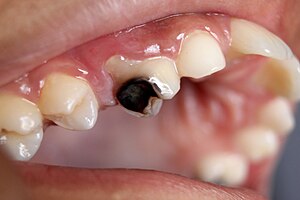**Group 1: Signs and Symptoms of Tooth Decay**
– Small spot of decay visible on tooth surface
– Appearance of chalky white spot on tooth surface
– Brown lesion turning into cavity
– Softening of affected tooth areas
– Pain from exposed dentinal tubules
**Group 2: Causes and Bacteria Associated with Tooth Decay**
– Tooth surface, caries-causing bacteria, fermentable carbohydrates, time needed for caries
– Adherence of food to teeth and acid production by bacteria
– Sheltered environment promoting cariogenic biofilm development
– Biofilm on teeth maturing to become cariogenic
– Socio-economic factors influencing caries occurrence
– Mutans streptococci and lactobacilli linked to cavities
– Cariogenic bacteria in dental plaque
– Local environmental changes triggering caries
– Specific bacteria like Streptococcus mutans and Lactobacillus causing caries
– Root caries caused by various bacteria like Lactobacillus acidophilus and Actinomyces spp.
**Group 3: Prevention, Treatment, and Global Impact of Tooth Decay**
– Regular teeth cleaning and low-sugar diet for prevention
– Fluoride intake from various sources
– Treating mother’s caries can reduce children’s risk
– Screening for early detection
– Various treatments for restoring or removing decayed teeth
– 3.6 billion people worldwide affected by dental caries
– Nearly all adults experience dental caries
– 620 million people affected by caries in baby teeth
– Increasing prevalence in children and adults
– Disease more common in developed countries due to sugar consumption
**Group 4: Factors Affecting Tooth Decay**
– Dietary sugars and their impact on tooth demineralization
– Frequency of acidic exposure affecting caries development
– Role of saliva in neutralizing acids and promoting remineralization
– Diseases, disorders, and structural factors influencing caries risk
– Effects of reduced salivary flow, medications, radiation therapy, and tobacco use on caries formation
**Group 5: Tooth Structure, Diagnosis, and Classification**
– Pathophysiology of dental caries development
– Structure and zones of enamel, dentin, and cementum affected by caries
– Role of sclerotic and tertiary dentin in response to caries
– Impact of cemental caries on older adults
– Diagnosis methods and G. V. Black Classification of Restorations for caries treatment
– Early childhood caries, rate of progression, and affected hard tissues in tooth decay
Tooth decay, also known as cavities or caries, is the breakdown of teeth due to acids produced by bacteria. The cavities may be a number of different colors, from yellow to black. Symptoms may include pain and difficulty eating. Complications may include inflammation of the tissue around the tooth, tooth loss and infection or abscess formation.
| Tooth decay | |
|---|---|
| Other names | Dental cavities, dental caries, cavities, caries |
 | |
| Destruction of a tooth by dental caries and disease | |
| Pronunciation |
|
| Specialty | Dentistry |
| Symptoms | Pain, tooth loss, difficulty eating |
| Complications | Inflammation around the tooth, tooth loss, infection or abscess formation |
| Duration | Long term |
| Causes | Bacteria producing acid from food debris |
| Risk factors | Diet high in simple sugar, diabetes mellitus, Sjögren syndrome, medications that decrease saliva |
| Prevention | Low-sugar diet, tooth brushing, fluoride, flossing |
| Medication | Paracetamol (acetaminophen), ibuprofen |
| Frequency | 3.6 billion (2016) |
The cause of cavities is acid from bacteria dissolving the hard tissues of the teeth (enamel, dentin and cementum). The acid is produced by the bacteria when they break down food debris or sugar on the tooth surface. Simple sugars in food are these bacteria's primary energy source and thus a diet high in simple sugar is a risk factor. If mineral breakdown is greater than buildup from sources such as saliva, caries results. Risk factors include conditions that result in less saliva, such as diabetes mellitus, Sjögren syndrome and some medications. Medications that decrease saliva production include antihistamines and antidepressants. Dental caries are also associated with poverty, poor cleaning of the mouth, and receding gums resulting in exposure of the roots of the teeth.
Prevention of dental caries includes regular cleaning of the teeth, a diet low in sugar, and small amounts of fluoride. Brushing one's teeth twice per day, and flossing between the teeth once a day is recommended. Fluoride may be acquired from water, salt or toothpaste among other sources. Treating a mother's dental caries may decrease the risk in her children by decreasing the number of certain bacteria she may spread to them. Screening can result in earlier detection. Depending on the extent of destruction, various treatments can be used to restore the tooth to proper function, or the tooth may be removed. There is no known method to grow back large amounts of tooth. The availability of treatment is often poor in the developing world. Paracetamol (acetaminophen) or ibuprofen may be taken for pain.
Worldwide, approximately 3.6 billion people (48% of the population) have dental caries in their permanent teeth as of 2016. The World Health Organization estimates that nearly all adults have dental caries at some point in time. In baby teeth it affects about 620 million people or 9% of the population. They have become more common in both children and adults in recent years. The disease is most common in the developed world due to greater simple sugar consumption, but less common in the developing world. Caries is Latin for "rottenness".
